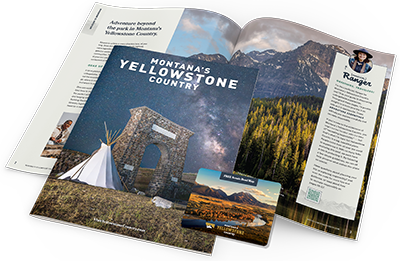Yellowstone National Park, the world’s first national park, covers 3,468 square miles. Three of the park’s five entrances are located in Montana’s Yellowstone Country.
Half of the world’s geothermal features are located in Yellowstone, which is what the park is most known for. The largest supervolcano on the continent is indicated by the Yellowstone Caldera, which fuels the ongoing seismic activity of the geysers.
Wildlife abounds, including grizzly bears, wolves, moose and free-ranging herds of bison and elk. The bison herd is the oldest and largest public bison herd in the U.S. Dawn and dusk are the best times for wildlife watching, when animals are most active.
You’ll find Trumpeter Swans along the Yellowstone River, and Sandhill Cranes near the Firehole River and in the Madison Valley. In 2013, there were a record 62 butterfly species identified in the annual butterfly count, some of which are rare and found mostly or only in the Yellowstone ecosystem, including the European Skipper and the Cabbage White Butterflies.
Operating Seasons
Yellowstone Park is accessible year-round, however, vehicular travel is limited in the winter. The road between the North and Northeast entrances (Gardiner to Cooke City) is open all year, but in winter the road closes at Cooke City and over-the-snow transportation, such as snowcoach or snowmobiles, are required at any of the other entrances.
The last day for vehicular travel throughout the rest of the park is the first Sunday in November, although the park is accessible by foot, skis or over-the snow transportation beginning December 15.
Vehicles are permitted again in the spring, starting with the West Entrance, which opens the third Friday in April, the East Entrance on the first Friday in May and the South Entrance on the second Friday in May.
For more information, call 307.344.2109.
Geysers
There are roughly 500 geysers in Yellowstone National Park, representing the majority of the world’s total number of geysers. Much of Yellowstone sits inside an ancient volcanic caldera (the exploded crater of a volcano). Nearly molten rock resides as little as 2 – 5 miles below the surface and seismic activity heats the ground water and creates thermal features, geysers, hot springs, fumaroles and mud pots.
Backcountry
Spending time in the backcountry of Yellowstone is like being in another world. You’ll experience miles of beauty and tranquility, whether it’s hiking, snowshoeing, backpacking or camping.
Camping requires a Backcountry Use Permit for all overnight stays. Campsites have a designated limit for the number of people and number of nights, for each location. Permits must be picked up, in person, no sooner than 48 hours in advance of your trip, but can be reserved in advance. Applications are accepted January 1 – October 31. Requests can be made by mail, by fax or in person, but not by phone or email. Permits are $25, regardless of the number of nights or people, and are non-refundable.
You can find more information on trip planning and can download the permit application at:
http://www.nps.gov/yell/planyourvisit/backcountrytripplanner.htm
Tours
The Yellowstone experience is unmatched, regardless of your means of seeing it, but to really learn about the intricacies of the land, wildlife and history, a guided tour is well worth it. Summer tours are available by foot, vehicle or water, and winter offers unique transportation opportunities, such as snowcoaches (similar to a passenger van), snowmobiles or Nordic skiing. In addition to park rangers, there are many private companies as well. Check the local Chambers of Commerce for suggestions, or click the link below for more information:
http://www.yellowstonenationalparklodges.com/things-to-do/winter-things-to-do/winter-activities-dates-rates/
Skiing
There are miles of Nordic ski trails in Yellowstone, with something for all abilities, whether it’s groomed trails in developed areas, guided tours or backcountry exploration. Regardless of your preference, proper preparation is required to optimize your experience. Unpredictable wildlife, changing weather, hydrothermal areas, deep snow, open streams and avalanches are all possibilities.
Detailed maps, concessionaires for skiing services and an instructional video to prepare for your adventure can all be found at:
http://www.nps.gov/yell/planyourvisit/skiyell.htm




